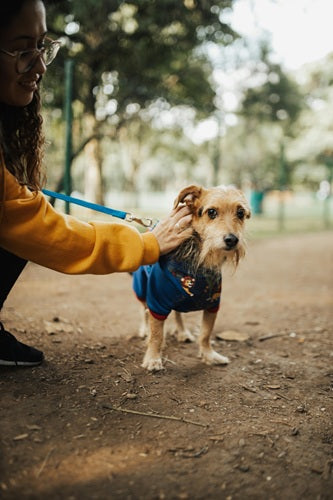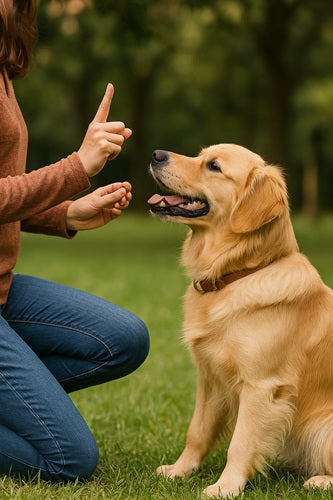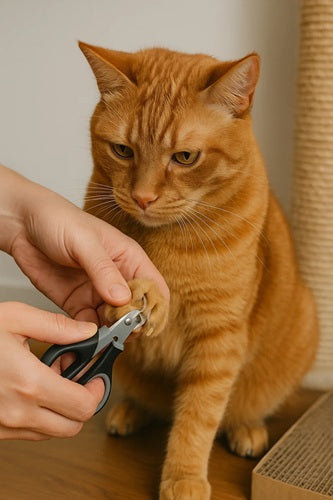Basic commands you should teach your dog
In order to have a strong relationship with your pet it is important to have strong communication and understanding. Training your pet to understand your basic commands is an important step towards this direction. Effective training helps to ensure discipline and obedience while making your dog more active and well-behaved.
Here are some essential commands that you can teach your pet.
Practice is an essential component in learning anything new. Practice any new command two to three times a day. It will take a few weeks for your pet to catch on but be patient and consistent. Most importantly, enjoy the experience.
1. Sit
By teaching your pet to “sit or stay”, you are helping him to learn self control. This command helps your pet stay controlled, especially in situations when he is super excitable.
How: To teach your pet to “sit”, hold a treat in your fist and put it above your dog’s head. Slowly move it behind their head and when they crouch, say “sit” and reward them.
2. Stay
The “stay” command will come in handy on a daily basis. This command helps you ensure the safety of your pet and others and hence its important to teach this at an early age.
How: To teach your pet to ‘stay’, have your dog start by sitting. Then slowly back away from your dog. If he or she moves toward you, say “no” and have them sit. When they stop, say “stay.” Then reward and say “come.”
3. Down
The ‘down’ command helps by giving your pet a moment to settle down in a hyperactive situation.
How: This command is a bit more challenging to master. Begin by holding a strong-smelling treat in front of your pup and wait for them to smell it. Once they do, bring the treat down to the floor and your dog will eventually follow. When their belly is on the floor say “down” and give them the treat
4. Wait
The ‘wait’ command is very similar to the ‘stay’ command but it is used for a specific purpose. Usually pets get super excited when the doorbell rings and someone enters the house. However, it is important to teach your pet not to charge at someone entering the house. This is when the ‘wait’ command comes in handy.
How: To teach your pet to “wait,” you need to have two people. One person should go outside your house and the other should stay inside with your dog. The person outside should open the door. When your dog starts moving toward the door the person inside should say “wait” as the person outside closes the door.
Repeat this multiple times and reward your dog when they don’t move towards the door.
5. Come
The “come” command helps you signal to your dog that you want him to come back to you. By teaching this command you can keep your pet safe and out of trouble. Use this command when your pet runs off or goes into an unsafe area.
How: While executing this command, simply put your dog on a leash and say the command while you tug lightly on their leash. When he or she comes to you, reward them with a treat. This is a complex command. Your pet might find it difficult to learn and you may find it difficult to execute, so be consistent and patient.
6. Leave it
The ‘leave it’ command will be super helpful on walks. Dogs are, by nature, super curious - they love exploring things along their walk that they possibly shouldn’t. Using this command, you are able to tell your dog not to grab or pick up something they are approaching or about to ingest.
How: Hold two treats, one in each hand. Show your dog one of the treats and then close your hand — hide the other treat behind your back. Keep the treat you showed him or her in a fist and wait for them to lose interest, all the while saying “leave it.”
Once they back away from the original treat, give them the treat you were hiding.
7. Shake
This isn't an essential, practical utility command. But it's a fun trick to teach your pet and have a good time with. Kids especially enjoy this command.
How: To teach your pet to “shake,” paws, begin by making your dog sit. Then, pick up their paw while saying “shake” and give them a treat. Hold it for two seconds, say “shake” again and give them another treat.
Teaching commands is a slow and gradual process. It won’t be easy but it will be worth it. Introduce one command at a time, giving your pet enough time to learn and master that before moving to the next one. With anything new, patience and consistency is the key. But once your pet has mastered all these commands he will be off to a super start. By teaching your pet these commands, you will be able to address any behavioral problems and enjoy a healthy and happy relationship with your furry friend.








